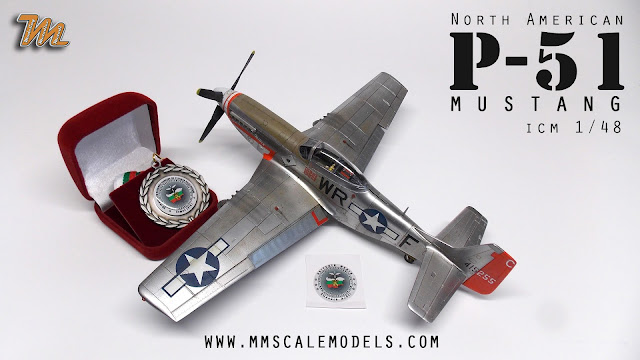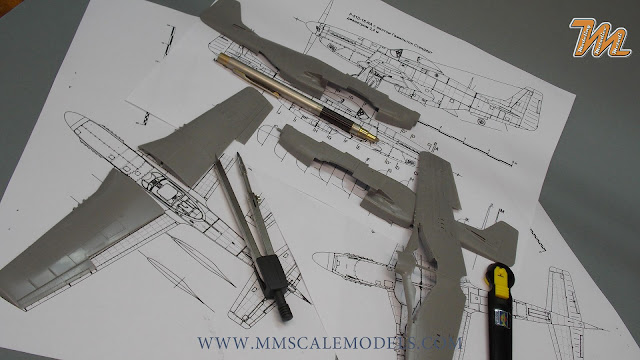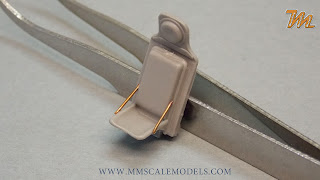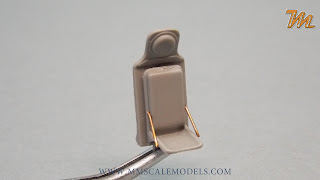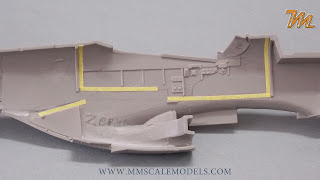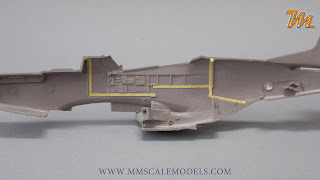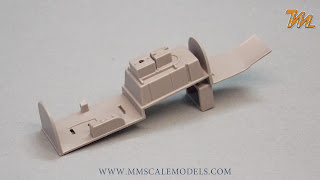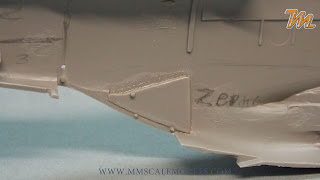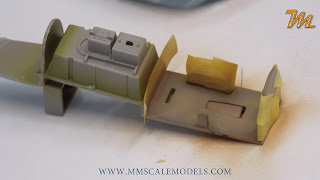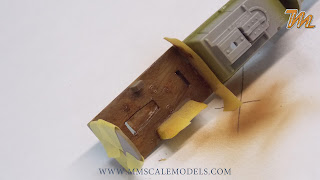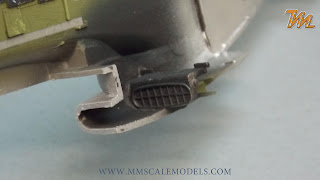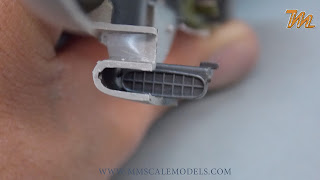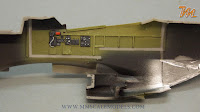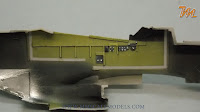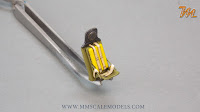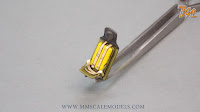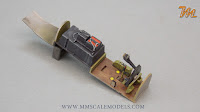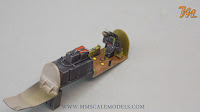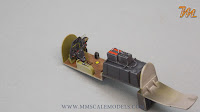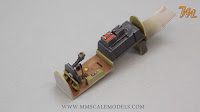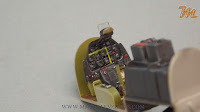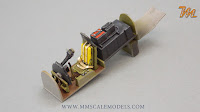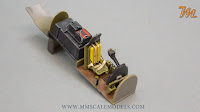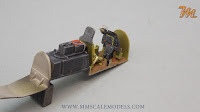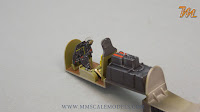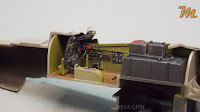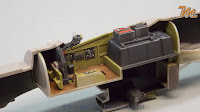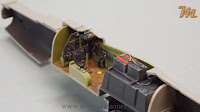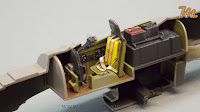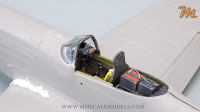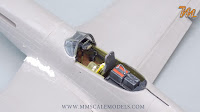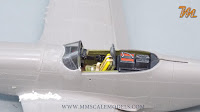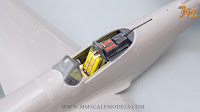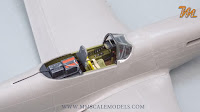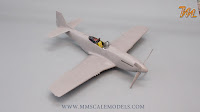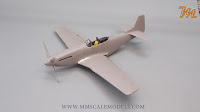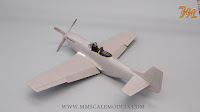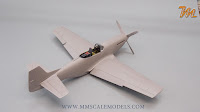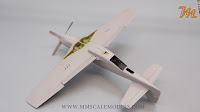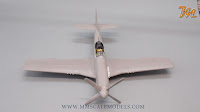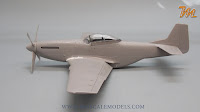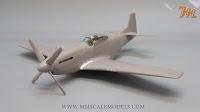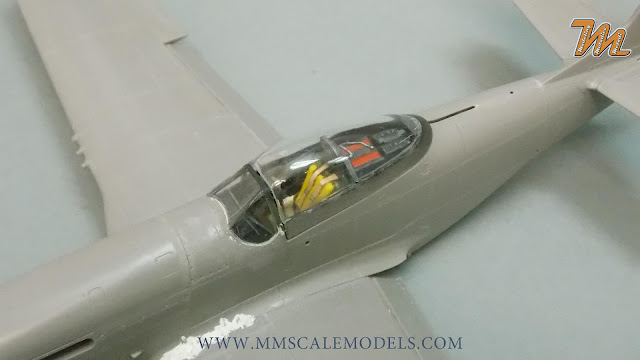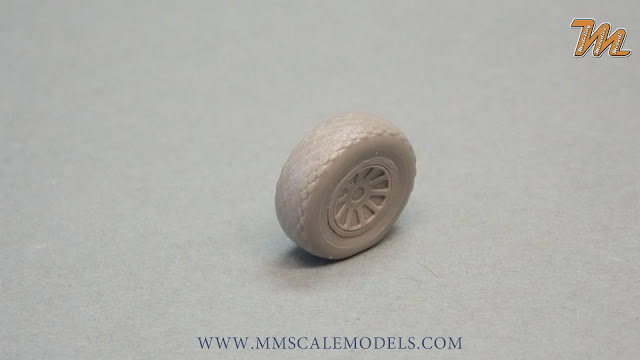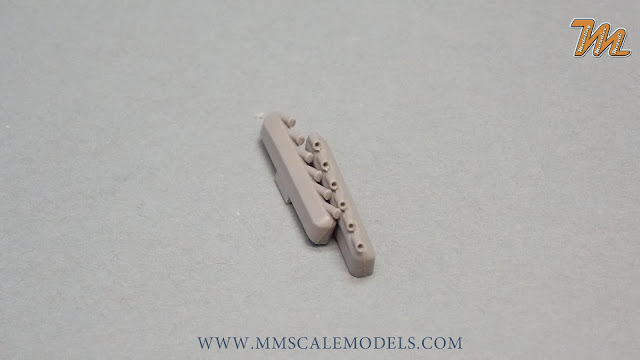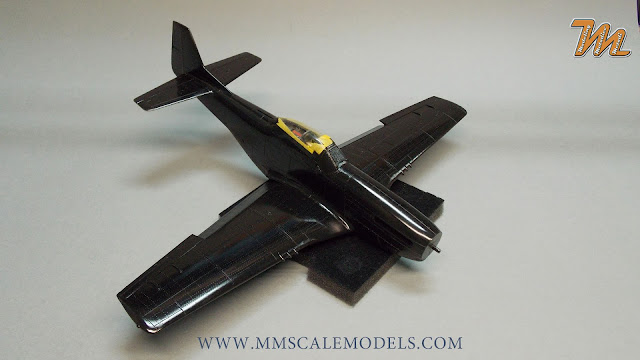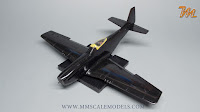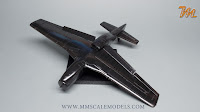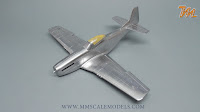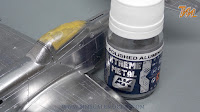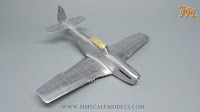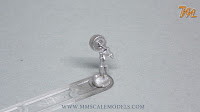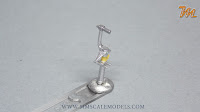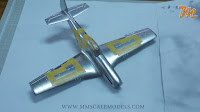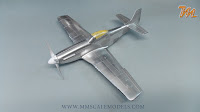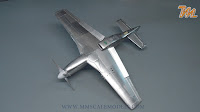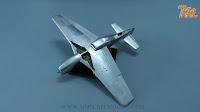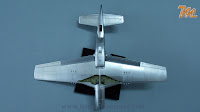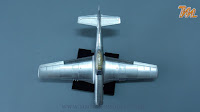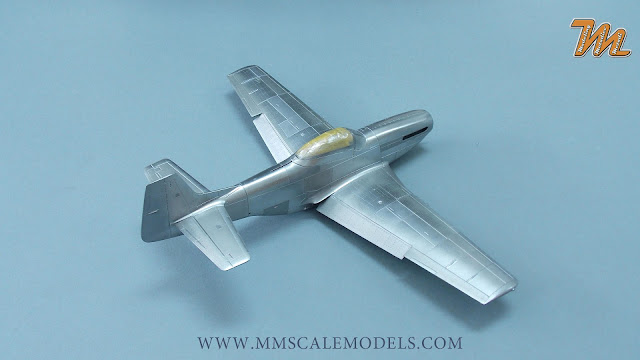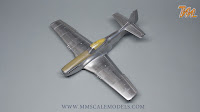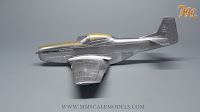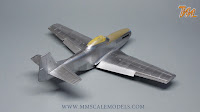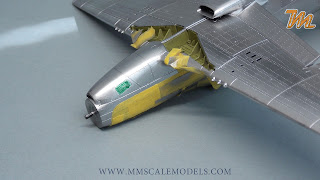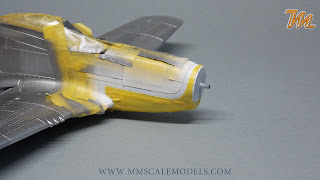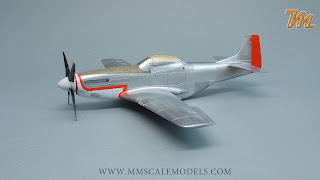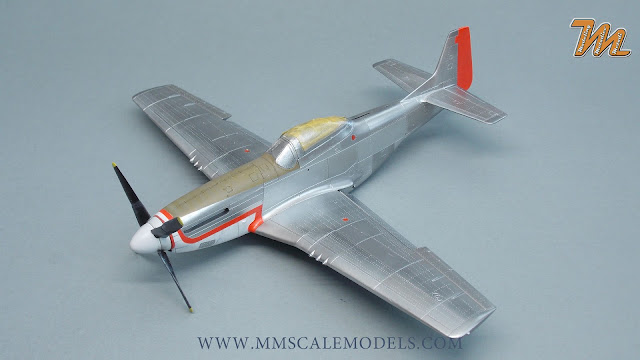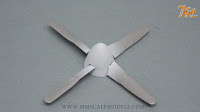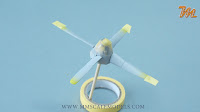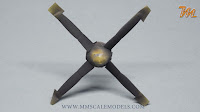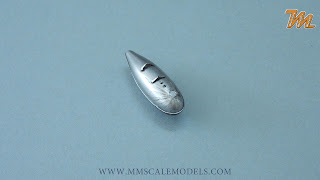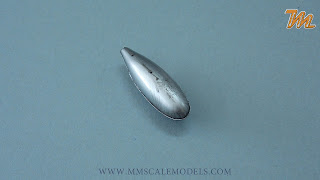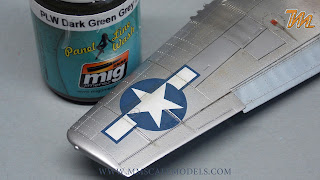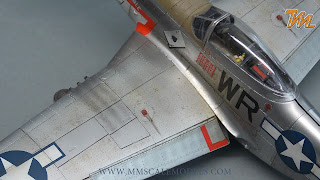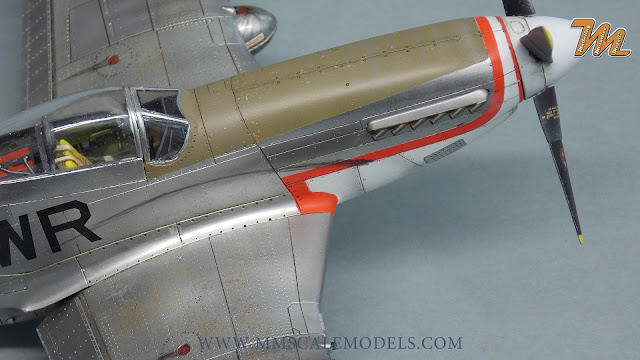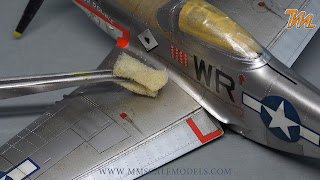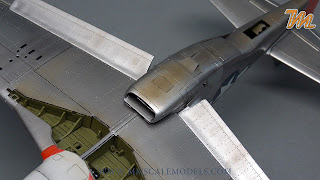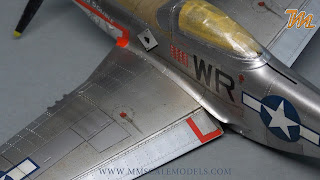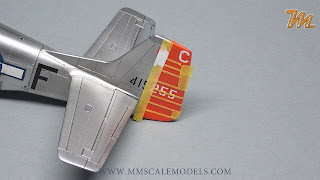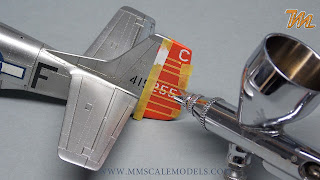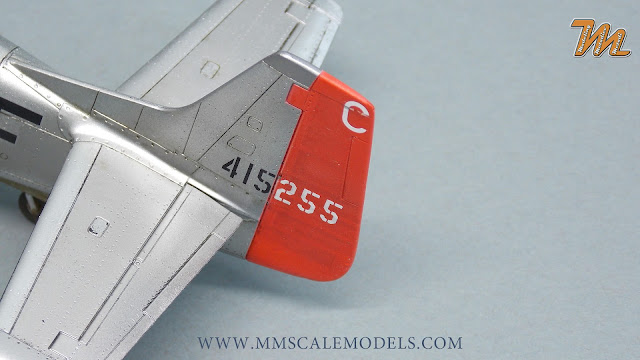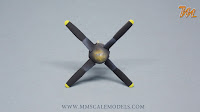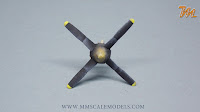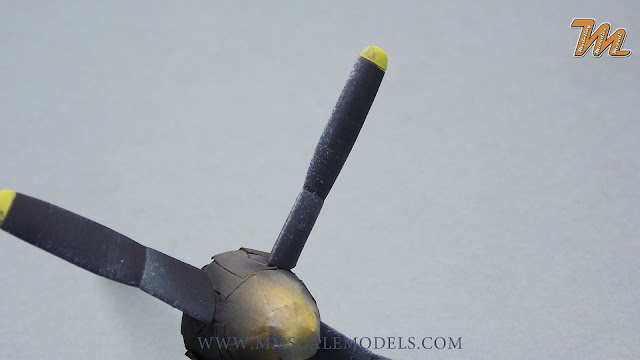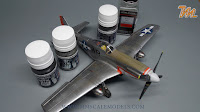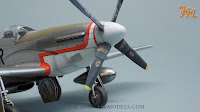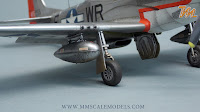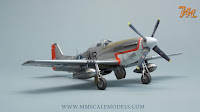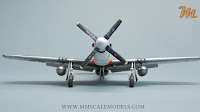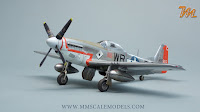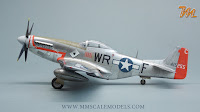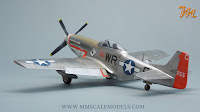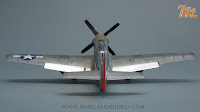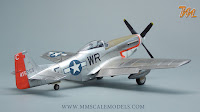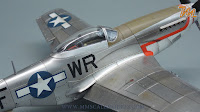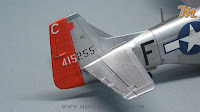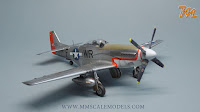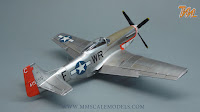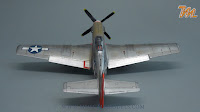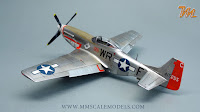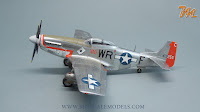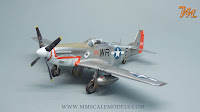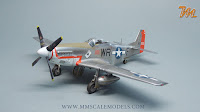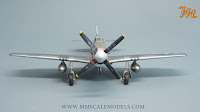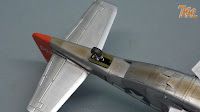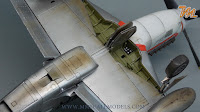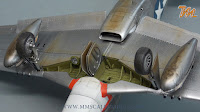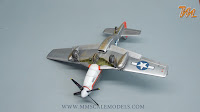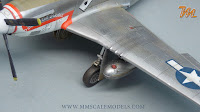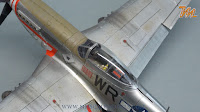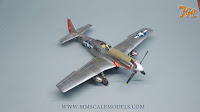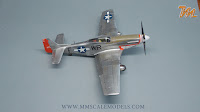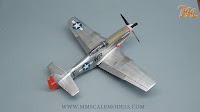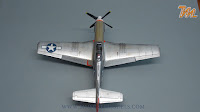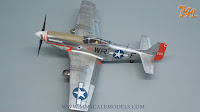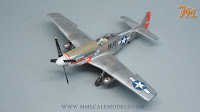North American P-51 D-15 Mustang
Plastic scale model build review, ICM, 1/48 scale
Riveting
I started this build with adding rivets to all the appropriate surface of the model. Riveting is essential for me, especially for natural metal finishes. I sourced scale drawings from the internet and adapted them to fit the model. In my work, I try to adapt the drawings to the model, as I find no point in relocating panel lines because they are a millimeter off.
Using the blueprints and a compass I transferred the rivet lines to the model, then using the metal ruler as guide I drew lines with mechanical pencil, later to follow with my riveting tool. Where the curvatures were too much for the metal ruler to bend, or there was not enough space for it, I used electrical tape. When I was one with the riveting tool, I sanded the surfaces down using fine grit sandpaper. To get the sanding dust away I washed the details with soapy water and toothbrush.
Cockpit
From the beginning, I decided to have the cockpit closed so I was not going to put many details in this area. Moreover, the kit offers some reasonable detail on the sidewalls, for the seat and the instrument panel. Only the gunsight was a little bit odd. Both the gunsight and instrument panel were moulded in clear plastic.
Since there were no instrument faces on the decal sheet provided with the kit, I decided to take advantage of their transparency. On the backside of each gauge, I scribed a line, and then I filled the line with white paint and wiped the excess away. Then I painted the rear with dark grey paint. Now the instrument panel looks like it have needles behind the glass. Later I covered the instrument faces with liquid mask. This was going to be OOB build but I added some details such as the seat harnesses and two cables to the radio. The seatbelts I did entirely from masking tape and for the radio cables, I used thin copper wire. I also removed the moulded reflector glass of the gunsight and replaced it with thin acetate sheet.
In order to have good adhesion between the plastic parts of the cockpit, I traced their location on the fuselage sides and covered the contact surfaces with thin strips of tape.
I assembled the cockpit floor with the provided bulkheads and the radiator. The radiator outlet sidewalls are supposed to be glued to the radiator/cockpit floor assembly and then to the fuselage halves, but in order to ensure food fit I glued the walls to each fuselage halve. I also installed the oil radiator on the right fuselage halve. At this point I had to make sure that I have good enough fit therefore I did many dry fits with adjustments (read removing excess material) in-between.
When the matching process was over, I started airbrushing matt black paint on the radiators and inner surfaces of the fuselage halves, except the sidewalls. Then I masked the area below the instrument panel shroud and sprayed Mr. Hobby H58 “Interior green” on the sidewalls and the appropriate areas of the cockpit floor. After masking everything around the floor, below the pilot, I sprayed buff colour then random areas of brown paint over it. This was the base for my wood simulation. Then I added a layer of burnt umber oil pant, using stiff brush, creating wood grain imitation. After I was satisfied with the way the “wood” looked, I applied a dull coat with the airbrush. The details on the radiators were highlighted with dry brushed steel enamel paint.
Since the cockpit was not going to be very visible behind the closed canopy, I decided that would not do nothing fancy and will use some simple painting techniques instead. For the interior green areas, I used bleached base colour and paintbrush to enhance the raised features. With even more white paint in the green, I added chips and scuffs using sponge.
With fine brush, I painted the black details and then dry brushed them with medium grey paint. The dry brushing was applied on the fuel tank, the radio boxes, the upper part of the pilot’s seat, the instrument panel and the cross member of the canopy frame. The small knobs and cables were detail painted with grey paint and some red to break the monotony. Mig/Ammo 1608 Dark green-grey panel line wash was applied to enhance the shadows.
The lower portion of the seat was painted in interior green, the back cushion – yellow and the headrest in black. I painted the harnesses in buff colour and used silver pen to replicate the belt buckles. To enhance the shadows between the belts and the cushion I used brown paint. To give more worn look to the headrest I made grey chips using sponge and then covered it with highly diluted brown paint.
With fine brush, I painted the black details and then dry brushed them with medium grey paint. The dry brushing was applied on the fuel tank, the radio boxes, the upper part of the pilot’s seat, the instrument panel and the cross member of the canopy frame. The small knobs and cables were detail painted with grey paint and some red to break the monotony. Mig/Ammo 1608 Dark green-grey panel line wash was applied to enhance the shadows.
The lower portion of the seat was painted in interior green, the back cushion – yellow and the headrest in black. I painted the harnesses in buff colour and used silver pen to replicate the belt buckles. To enhance the shadows between the belts and the cushion I used brown paint. To give more worn look to the headrest I made grey chips using sponge and then covered it with highly diluted brown paint.
After the painting process was completed, I assembled the cockpit floor with the instrument panel then glued them to the left fuselage halve. I left the seat for a later point. Some parts needed to be forced on their places but the fast drying time of Mr. Hobby’s Cement S made things easier. Clamps were used to secure everything for couple of hours until the cement was completely set.
After the fuselage halves got together I glued the cross member to the canopy frame and then to the canopy itself. To glue the seat in place I used liquid cement with longer drying time and then I installed the canopy in place. This way I used the cross member of the canopy frame, to position the seat in the correct angle.
Wings and fuselage
Closing the fuselage halves together required some more adjustments but that was well worthed. I glued the fuselage halves together, using liquid cement, in inch-by-inch manner so I can massage everything in place. This technique and the careful dry adjustment resulted in almost perfect joint with only minimal seam lines and barely existent steps. The cleverly designed upper portion of the engine cowling simply slotted over and around the fuselage halves employing panel lines as joints. To keep the silhouette of the airplane unspoiled I attached the radiator outlet door in fully closed position.
The wings are provided as one full span lower part and two upper parts. First, to install was the main gear bay, which goes in the middle of the lower wing, giving the correct (or manufacturer pre-set) dihedral angle. Trimming was necessary as everywhere else. I glued the bay in place using liquid cement and then used strong clamps to hold the piece in place. Later the upper wings were installed considering the panel lines alignment and the fit with the fuselage. After the glue was set, I sanded the joints. No filler was required as the melted plastic did that job.
Attaching the wings to the fuselage was a bit more troublesome there was flash and miss moulded plastic on the way. After clan up, I made enough space to slot the wing centre line under the air intake, fit it behind the cowling and on both wing root fairings. Just a small amount of filler was needed on the left-front wing root and a plastic card insert for a small gap between the wing centre section and the lower cowling. The horizontal stabilizers were easy job and went in without any issues. After sanding the little filler used on the seam lines I rescribed the lost panel lines. Finally, I installed the flaps in lowered position.
The windshield and the canopy were masked from inside and outside, then sprayed with flat black on both sides. After removing the inside masks from the windshield I glued it to the fuselage using Mr. Cement S and blended them using Mr. Dissolved putty. Then I glued the canopy in closed position. Since it is not the clearest canopy in the world now the cockpit is barely visible. A little gap formed between the windshield and the canopy front frame. I filled it with white glue in order to avoid overspray inside the cockpit.
The propeller assembly is quite nice. Each blade fits in attachment point designed in such a way that introduces identical pitch angle for all of them. Then this assembly hides below the spinner.
Each of the main wheels is a three parts deal, with the rims being represented as inserts for both sides of the tires. The details on the rims are good bud the moulding is poor so lots of trimming was necessary to get a good fit with the tire. I removed the flash from the mould line of the tires and restored the thread.
Small jobs as drilling the exhaust pipes and gun barrels always give excellent results. I start with making centre mark with needle and then I drill with the smallest size drill I have, in this case 0.2mm. Then I take progressively larger sizes until the wall of the tube is with appropriate thickness – gun barrels have much thicker walls than exhaust pipes.
Prep and painting.
I painted the wheel wells with the Interior green I used for the cockpit and applied the same weathering techniques. The details are rather good OOB. To mask the main gearbay I used the doors, attaching them with blue-tack. For ease of painting parts like the gear legs were attached to plastic coffee stirrers using blue-tack as well.
From this point the handling of the model was only done with gloves on my hands. I cleaned up the surface using alcohol and primed the model with Mr. Hobby C02 (that is the nitro range) gloss black. That was left to dry overnight. Then I applied AK 481 “Polished aluminium” in several thin coats and also left it to dry overnight.
To break the surface monotony I did some “paneling”. Looking at photographs of the real aircraft I made a “map” of where I may put different metal shades. I reduced the tackiness of some masking tape and masked around certain panels. Smaller panels, I masked using liquid masking solution. I loaded the airbrush with some AK 480 “Dark aluminium” and laid down a few coats. When I was happy with the colour I removed the masking.
I didn’t clean up the airbrush from the small left over quantity of “dark aluminium” but poured in some AK 482 “Duraluminium”. This way I reduced the golden effect of the latter. I decided to spray the mix freehand. This gave more subtle tonal and sheen variation than if masking was used. To seal the finish I used “Sealer for Metalizer” from Model Master, this sealant is the best for natural metal finishes in my experience.
To break the surface monotony I did some “paneling”. Looking at photographs of the real aircraft I made a “map” of where I may put different metal shades. I reduced the tackiness of some masking tape and masked around certain panels. Smaller panels, I masked using liquid masking solution. I loaded the airbrush with some AK 480 “Dark aluminium” and laid down a few coats. When I was happy with the colour I removed the masking.
I didn’t clean up the airbrush from the small left over quantity of “dark aluminium” but poured in some AK 482 “Duraluminium”. This way I reduced the golden effect of the latter. I decided to spray the mix freehand. This gave more subtle tonal and sheen variation than if masking was used. To seal the finish I used “Sealer for Metalizer” from Model Master, this sealant is the best for natural metal finishes in my experience.
Next I masked for the anti-glare panel and airbrushed AK 135 “Olive Drab Light Base” then I masked off the cowling section and sprayed AK 136 “Olive Drab Highlights”. This tonal variation is visible on pictures of the actual aircraft. Ultimately the anti-glare panel received some fading with 10% White to 90% thinner mixture.
The nose art was the next task. To create a mask I used the AeroMaster decal as template and traced the shape to masking tape. Then I cut the shape with scalpel and placed the mask on the nose. Using liquid mask I masked the vents on the cowling, also I masked the tail so I can paint the rudder. The painting started with a coat of Mr. Hobby H11 “Flat white”. Then, in the same manner as previously I made another mask in order to paint the red band. The color I used was Lifecolor LC52 “Gloss Red” both for the nose and the rudder, as well as for the fuel caps. After removing the lower portion of the masking I put a gloss layer on the nose art and removed the rest of the masking.
The propeller assembly got a coat of Mr. Surfacer 1500. The spinner was painted in white and the propeller tips in yellow. I weathered the spinner by masking in front of the panel line and making several passes with soft pencil over the panel line. Then, using paint brush I blended the graphite backwards. After masking the spinner and the tips I applied flat black to the propellers.
The exhaust stacks were painted in flat black and then dry-brushed with steel. To give them burnt and rusty appearance I applied rust colour filter.
Using sponge I applied highly diluted earth colour on the high traffic areas, the lower parts of the gear bay doors and on the underside of the aircraft. To blend the dirt I lightly airbrushed the same mixture on several locations.
The exhaust stacks were painted in flat black and then dry-brushed with steel. To give them burnt and rusty appearance I applied rust colour filter.
Decals and weathering
From the kit decals I used only the national insignias as strangely enough they were not included in the AeroMaster set. Both ICM’s and AeroMaster’s decals were reluctant to get into the recessed details and also “tented” on the raised details.
Mr. Mark setter and Softer didn’t help much although I used them in liberal quantities. To address the issue I used the scalpel blade to help the decals adapt to the surface. The insignias were faded using highly diluted white paint.
To simulate some dirt I used highly diluted black applied over the panel lines while the upper of the panels was masked. I sealed the decals with a layer of “Sealer for Metalizers”.
Weathering
For the weathering I started with the green-grey panel line wash. With AK 2032 “Shaft and bearing Grease” I made fuel stains and streaks from the fuel caps on the airplane and on the external fuel tanks.
Same product was used to replicate the distinctive oil streak on the right fuselage side.
Using sponge I applied highly diluted earth colour on the high traffic areas, the lower parts of the gear bay doors and on the underside of the aircraft. To blend the dirt I lightly airbrushed the same mixture on several locations.
To further enhance the dust and dirt accumulation I brushed earth colour pigment on the high traffic areas and on the wheels.
To better define the ribs of the rudder I cut thin strips of masking tape and masked the raised parts. Then using a blend of 90% thinner and 10% flat black paint, I lightly airbrushed over the tape but keeping the spray as tight as possible. Using the same paint mix I simulated the exhaust stains from the guns and from the exhaust stacks. Ammo/Mig satin varnish was applied over the areas with colour different than NMF.
To weather the propeller blades I masked them from the cuffs up and airbrushed highly diluted grey paint on the leading edge and on the upper edge of the cuffs. After removing the masks I applied the same mixture on the rest of the leading edge and also made few streaks along the direction of rotation. Using lighter shade of grey and sponge I added paint chipping and few scratches. For the chips on the yellow I used graphite pencil. Prior to decaling I applied gloss varnish. After I was ready with the decals the complete propeller assembly received satin varnish.
Final assembly
At the home straight I installed the landing gear and the gear bay doors as well as the external fuel tanks and an antennae.
Conclusion
While not being moulded in the highest standards, the kit provided decent details and good accuracy. Extra time and effort spent on improving the fit saved me a lot of time that I would have spent applying and sanding putty. Overall I am very pleased with the final result and looking forward to my next build.
This model was awarded with second place in its category on the XII-th open competition for scale models, Sofia, Bulgaria, 2016
Best regards and happy modeling
Metodi

